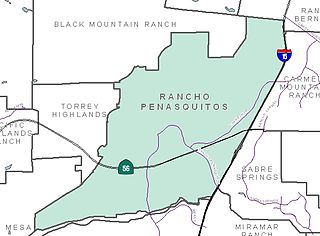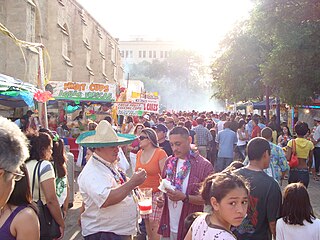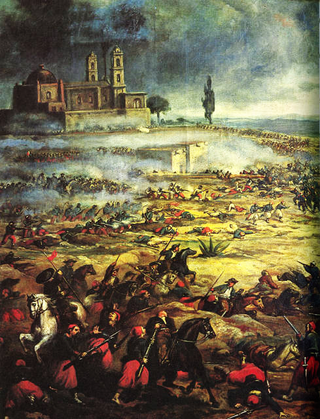La Tomatina is a Spanish festival in Buñol, Spain where participants throw tomatoes at each other. It is said to be the biggest food fight in the world. From the festival's origin as a food fight between friends in the 1940s, it has become a famous tourist attraction. Prior to 2013, the festival did not operate with an upper cap on the number of attendees which would cause a strain on Buñol's population of about 9,000 inhabitants. Since 2013, however, the festival has a ticketed event with a capacity of 20,000 participants.
The festival of San Fermín is a week-long, traditional celebration held annually in the city of Pamplona, Navarre, Spain. The celebrations start at noon on 6 July and continue until midnight on 14 July. A firework (chupinazo) starts the celebrations and the popular song Pobre de mí is sung at the end.

A Little Manila, also known as a Manilatown or Filipinotown, is a community with a large Filipino immigrant and descendant population. Little Manilas are enclaves of Overseas Filipinos consisting of people of Filipino origin living outside of the Philippines.

Moros y Cristianos or Moros i Cristians, literally in English Moors and Christians, is a set of festival activities which are celebrated in many towns and cities of Spain, mainly in the southern Valencian Community. According to popular tradition the festivals commemorate the battles, combats and fights between Moors and Christians during the period known as Reconquista. There are also festivals of Moros y Cristianos in Spanish America.

The carnival in Colombia was introduced by the Spaniards. The Colombian carnival has incorporated elements from European culture, and has managed to syncretise, or re-interpret, traditions that belonged to the African and Amerindian cultures of Colombia. There is documentary evidence that the carnival existed in Colombia in the 17th century and had already caused concern to the colonial authorities, who censored the celebrations, especially in the main centers of power such as Cartagena, Bogotá and Popayán. The carnival, therefore, continued its evolution and re-interpretation in the small and at that time unimportant towns where celebrations did not offend the ruling elites. The result was the uninterrupted celebration of carnival festivals in Barranquilla, and other villages along the lower Magdalena River in northern Colombia, and in Pasto, Nariño in the south of the country. In modern times, there have been attempts to introduce the carnival in the capital, Bogotá, in the early 20th century, but it has always failed to gain the approval of authorities. The Bogotá Carnival has had to wait until the 21st century to be resurrected, this time, by the authorities of the city. Colombia is recognized by its large variety of festivals, carnivals and fairs. Most towns have their own, ranging from those celebrating coffee to the ones held in honor of the town's Saint feast. The common characteristics of the festivals are the nomination of a beauty Queen and the setting up of public dance floor.

The San Antonio River is a major waterway that originates in central Texas in a cluster of springs in midtown San Antonio, about 4 miles north of downtown, and follows a roughly southeastern path through the state. It eventually feeds into the Guadalupe River about 10 miles from San Antonio Bay on the Gulf of Mexico. The river is 240 miles long and crosses five counties: Bexar, Goliad, Karnes, Refugio, and Wilson.

The Global Marijuana March (GMM), also referred to as the Million Marijuana March (MMM), is an annual rally held at different locations around the world on the first Saturday in May. A notable event in cannabis culture, it is associated with cannabis-themed events, which may include marches, meetings, rallies, raves, concerts, festivals, and attempts at educational outreach.

The LA Pride Festival & Parade, commonly known as LA Pride, is an annual LGBTQ Pride celebration in Los Angeles, California. It is one of the largest LGBTQ Pride events in the world, traditionally held on the second weekend of June, and produced by the Christopher Street West Association.

Rancho Peñasquitos is a suburban community in the northeastern part of the city of San Diego, California. It is named after the first Mexican land grant in the county, Rancho Santa Maria de Los Peñasquitos. The community abuts Los Peñasquitos Canyon Preserve, an open space preserve that offers hiking, biking, and equestrian trails. The community is commonly abbreviated "PQ."

Fiesta San Antonio is an annual festival held in April in San Antonio, Texas, and is the city's signature event since 1891. The festival, also known as the Battle of Flowers, commemorates of the Battle of the Alamo, which took place in San Antonio, and the Battle of San Jacinto, which led to Texas' independence from Mexico in April 1836.

The Equidome is a 3,500-seat indoor arena located at the Los Angeles Equestrian Center complex, located next to the Los Angeles River on Riverside Drive in Burbank, Los Angeles County, California.

The culture of San Antonio reflects the history and culture of one of the state's oldest and largest cities straddling the regional and cultural divide between South and Central Texas. Historically, San Antonio culture comes from a blend of Central Texas and South Texas (Southwestern) culture. Founded as a Spanish outpost and the first civil settlement in Texas, San Antonio is heavily influenced by Mexican American culture due to Texas formerly being part of Mexico and, previously, the Spanish Empire. The city also has significant German, Anglo, and African American cultural influences. San Antonio offers a host of cultural institutions, events, restaurants and nightlife in South Texas for both residents and visitors alike.

Mardi Gras in the United States is celebrated in a number of cities and regions in the country. Most of these places trace their Mardi Gras celebrations to French, Spanish, and other Catholic colonial influences on the settlements over their history.

Cinco de Mayo is an annual celebration held on May 5 to celebrate Mexico's victory over the Second French Empire at the Battle of Puebla in 1862, led by General Ignacio Zaragoza. Zaragoza died months after the battle from an illness, however, and a larger French force ultimately defeated the Mexican army at the Second Battle of Puebla and then occupied Mexico City. Following the end of the American Civil War in 1865, the United States began lending money and guns to the Mexican Liberals, pushing France and Mexican Conservatives to the edge of defeat. At the opening of the French chambers in January 1866, Napoleon III announced that he would withdraw French troops from Mexico. In reply to a French request for American neutrality, the American secretary of state William H. Seward replied that French withdrawal from Mexico should be unconditional.

Pershing Square is a small public park in Downtown Los Angeles, California, one square block in size, bounded by 5th Street to the north, 6th Street to the south, Hill Street to the east, and Olive Street to the west. Originally dedicated in 1866 by Mayor Cristóbal Aguilar as La Plaza Abaja, the square has had numerous names over the years until it was finally dedicated in honor of General John J. Pershing in 1918.
Numerous events and festivals are held annually in Metro Manila. They include:
The iHeartRadio Fiesta Latina is a music festival sponsored by iHeartRadio. The inaugural 2014 edition was held on November 22 at The Forum in Inglewood, California, near Los Angeles. It was produced in association with Live Nation Entertainment. The festival is "a spin-off of the highly successful iHeartRadio Music Festival" dedicated to Latin music.
Fiesta Broadway is an annual event held in downtown Los Angeles to celebrate Cinco de Mayo, Mexican culture and Latin American culture in general. Modeled on Miami's Calle Ocho Festival and harking back to the early 20th-century Fiesta de Los Angeles, it features vendors and musical acts. At its peak, Fiesta Broadway stretched for 36 blocks centered on a long stretch of Broadway and attracted hundreds of thousands of visitors. More recently it has been confined to a few blocks around 1st Street and Broadway and has seen attendance shrink to as little as 7,000. Although the holiday of Cinco de Mayo falls on May 5, which is the meaning of its Spanish name, Fiesta Broadway is always held on the last Sunday in April, since 1995.
Fiesta Park was a grandstand and sports and entertainment venue in South Park, Los Angeles, California. From 1894 to 1916, it served as venue for various exhibitions and festivals, as well as a field for USC Trojans football games.














